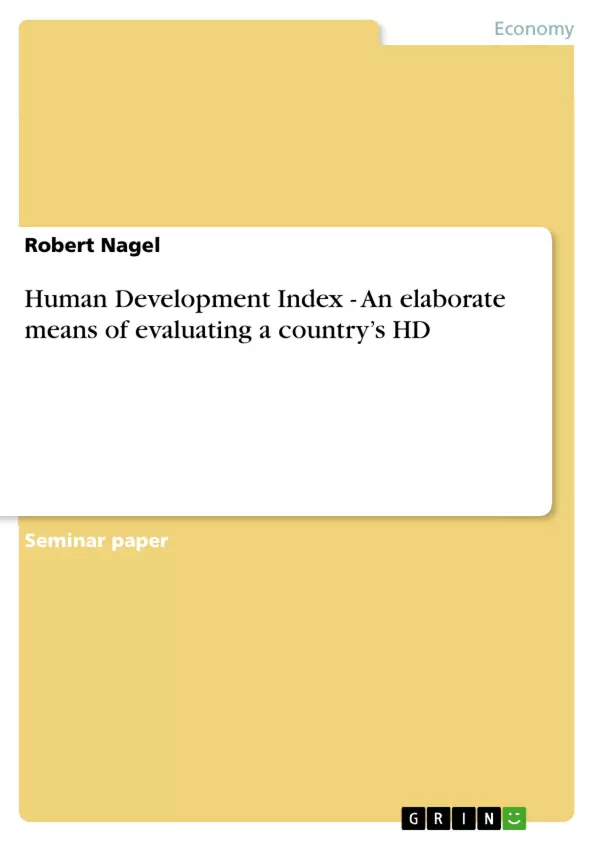Why was an index like the Human Development Index (HDI) established in the first place? That question and what the HDI really is about is the topic of this paper. The aim is to highlight its uniqueness and show how it differentiates from other measurement tools of human development. This assignment was done with secondary research only. For a topic that young there are efficient internet sources available which were sufficient enough to complete the assignment based on the oral presentation.
Inhaltsverzeichnis (Table of Contents)
- Introduction
- What is the human development index (HDI)?
- Background of the HDI
- Five criteria for the HDI measures
- Simplicity
- Universality
- Sufficient attractiveness
- Pluralism
- Synthesis
- Components of the HDI
- Life Expectancy
- Education Index
- Functional Literacy Rate
- Combined Elementary and Secondary Enrolment Rates
- Income Index
- Indicators Used in the Estimation of the HDI
- health as measured by life expectancy
- Level of knowledge and skills
- Combined Enrolment Rate
- Net Enrolment Rate
- Real Per Capita Income
- Fixed minimum and maximum values
- HDI values
- The New HDI
- Methodological changes
- New and improved data series
- A comparative Case Study: Norway versus Canada
- Common failings of the HDI
- Regions and Districts
- Ethic Groups
- Gender
- The HDI in comparison
- Economic Growth
- Human Capita Formation
- Basic Need Approach
- HDI
- HDI achievements
- Discussion part
Zielsetzung und Themenschwerpunkte (Objectives and Key Themes)
This paper aims to explain the rationale behind the creation of the Human Development Index (HDI) and its significance in evaluating a country's human development. It explores the key characteristics of the HDI, differentiating it from other development indicators. The paper investigates the methodology, components, and evolution of the HDI, highlighting its strengths and limitations.
- The origins and rationale for the HDI's creation.
- The key components and methodology of the HDI.
- The evolution and refinement of the HDI over time.
- Comparative analysis of the HDI's strengths and weaknesses.
- The HDI's place within a broader context of human development indicators.
Zusammenfassung der Kapitel (Chapter Summaries)
- Introduction: This chapter establishes the context for the paper, introducing the Human Development Index (HDI) and its significance in measuring human development. It highlights the need for a comprehensive measure beyond traditional economic indicators like GDP.
- What is the Human Development Index (HDI)? This chapter defines the HDI as a composite index measuring a country's average achievements in longevity, knowledge, and standard of living. It explains the three key components of the HDI: life expectancy, education, and income.
- Background of the HDI: This chapter delves into the history and development of the HDI, discussing the initial skepticism surrounding its creation and the evolution of its methodology and data collection.
- Five criteria for the HDI measures: This chapter outlines the five criteria that guided the development of the HDI, emphasizing the importance of simplicity, universality, attractiveness, pluralism, and synthesis in its construction.
- Components of the HDI: This chapter provides detailed explanations of each component of the HDI, including life expectancy, education index (functional literacy rate and enrolment rates), and income index.
- The New HDI: This chapter explores the changes implemented in the HDI, including methodological improvements and the use of updated data series.
- A comparative Case Study: Norway versus Canada: This chapter examines the application of the HDI to specific countries, providing a comparative analysis of Norway and Canada.
- Common failings of the HDI: This chapter discusses the limitations of the HDI, exploring how it may not adequately reflect regional disparities, ethnic group differences, or gender inequalities.
- The HDI in comparison: This chapter situates the HDI within a broader context of development indicators, comparing it to economic growth, human capital formation, and the basic needs approach.
Schlüsselwörter (Keywords)
The main keywords and focus topics of this text include the Human Development Index (HDI), human development, longevity, knowledge, standard of living, life expectancy, education index, income index, data collection, methodology, comparative analysis, and development indicators.
- Quote paper
- Robert Nagel (Author), 2004, Human Development Index - An elaborate means of evaluating a country’s HD, Munich, GRIN Verlag, https://www.grin.com/document/62262



